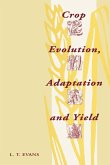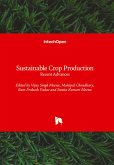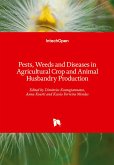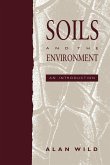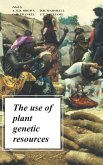P. K. McEwen / T. R. New / A. E. Whittington (eds.)
Lacewings in the Crop Environment
Herausgeber: McEwen, P. K.; Whittington, A. E.; New, T. R.
P. K. McEwen / T. R. New / A. E. Whittington (eds.)
Lacewings in the Crop Environment
Herausgeber: McEwen, P. K.; Whittington, A. E.; New, T. R.
- Broschiertes Buch
- Merkliste
- Auf die Merkliste
- Bewerten Bewerten
- Teilen
- Produkt teilen
- Produkterinnerung
- Produkterinnerung
Lacewings are predatory insects which attack and kill large numbers of insect pests. Lacewings in the Crop Environment addresses both the theoretical and practical aspects of lacewing biology and their use in crop protection. The book opens with a section on lacewing systematics and ecology. Next, lacewings as predators in a wide variety of commercially important crops are reviewed and this is followed by a section on the principles of using lacewings in pest control. The possible impact of genetically modified crops on lacewing populations is also discussed. Finally, a fascinating array of…mehr
Andere Kunden interessierten sich auch für
![Molecular Biology and Crop Improvement Molecular Biology and Crop Improvement]() R. B. AustinMolecular Biology and Crop Improvement47,99 €
R. B. AustinMolecular Biology and Crop Improvement47,99 €![Crop Evolution, Adaptation and Yield Crop Evolution, Adaptation and Yield]() L. T. EvansCrop Evolution, Adaptation and Yield91,99 €
L. T. EvansCrop Evolution, Adaptation and Yield91,99 €![Rice Crop Rice Crop]() Rice Crop89,99 €
Rice Crop89,99 €![Sustainable Crop Production Sustainable Crop Production]() Sustainable Crop Production129,00 €
Sustainable Crop Production129,00 €![Pests, Weeds and Diseases in Agricultural Crop and Animal Husbandry Production Pests, Weeds and Diseases in Agricultural Crop and Animal Husbandry Production]() Pests, Weeds and Diseases in Agricultural Crop and Animal Husbandry Production129,00 €
Pests, Weeds and Diseases in Agricultural Crop and Animal Husbandry Production129,00 €![Soils and the Environment Soils and the Environment]() Alan WildSoils and the Environment95,99 €
Alan WildSoils and the Environment95,99 €![The Use of Plant Genetic Resou The Use of Plant Genetic Resou]() A. H. D. Brown / O. H. Frankel / D. R. Marshall / J. T. Williams (eds.)The Use of Plant Genetic Resou155,99 €
A. H. D. Brown / O. H. Frankel / D. R. Marshall / J. T. Williams (eds.)The Use of Plant Genetic Resou155,99 €-
-
-
Lacewings are predatory insects which attack and kill large numbers of insect pests. Lacewings in the Crop Environment addresses both the theoretical and practical aspects of lacewing biology and their use in crop protection. The book opens with a section on lacewing systematics and ecology. Next, lacewings as predators in a wide variety of commercially important crops are reviewed and this is followed by a section on the principles of using lacewings in pest control. The possible impact of genetically modified crops on lacewing populations is also discussed. Finally, a fascinating array of case studies of lacewing use in many crops from around the world is presented, and future uses of lacewings speculated upon. Lacewings in the Crop Environment is an essential reference work and practical handbook for students, researchers of biological control, integrated pest management and agricultural science, and for field workers using lacewings in pest management programmes worldwide.
Hinweis: Dieser Artikel kann nur an eine deutsche Lieferadresse ausgeliefert werden.
Hinweis: Dieser Artikel kann nur an eine deutsche Lieferadresse ausgeliefert werden.
Produktdetails
- Produktdetails
- Verlag: Cambridge University Press
- Seitenzahl: 568
- Erscheinungstermin: 30. März 2007
- Englisch
- Abmessung: 246mm x 189mm x 30mm
- Gewicht: 1084g
- ISBN-13: 9780521037297
- ISBN-10: 0521037298
- Artikelnr.: 22783663
- Herstellerkennzeichnung
- Libri GmbH
- Europaallee 1
- 36244 Bad Hersfeld
- gpsr@libri.de
- Verlag: Cambridge University Press
- Seitenzahl: 568
- Erscheinungstermin: 30. März 2007
- Englisch
- Abmessung: 246mm x 189mm x 30mm
- Gewicht: 1084g
- ISBN-13: 9780521037297
- ISBN-10: 0521037298
- Artikelnr.: 22783663
- Herstellerkennzeichnung
- Libri GmbH
- Europaallee 1
- 36244 Bad Hersfeld
- gpsr@libri.de
Andrew Whittington is an entomologist specialised in the identification and naming of insects, most particularly, but not exclusively, dealing with flies (Diptera). He has more than a dozen year's experience as a fly taxonomist, has written approximately 50 scientific papers and described and named more than 60 new species. Andrew has collected extensively in the field, in countries as widespread as Finland, Germany, Hungary, Kenya, Lesotho, Namibia, Scotland, South Africa, Swaziland and Switzerland. During the course of research, he has examined thousands of specimens from all over the world, mainly in the orders (in decreasing magnitude) Diptera, Coleoptera, Neuroptera, Plecoptera, Odonata, Hemiptera, Mecoptera and Hymenoptera. The breadth of knowledge obtained during this broad range of research has been applied previously to forensic, medical, public health and environmental work in South Africa. It has now developed into an insect identification service in Scotland for ecological and environmental contracts for SAC, MLURI, SNH and SWT as well as Public Health assessments for Fife and Edinburgh Councils, Fyffes, The Medicines Testing Laboratories, United Distillers Vintners and GM Pests. Andrew is a Fellow of the Royal Entomological Society and Honorary Fellow of the School of Molecular and Clinical Medicine, College of Medicine and Veterinary Science, University of Edinburgh and is affiliated with Glasgow University Archaeological Research Division (GUARD).
List of contributors; Preface; Part I. Lacewing Systematics and Ecology: 1.
Introduction to the Neuroptera: what are they and how do they operate? T.
R. New; 2. Introduction to the systematics and distribution of
Coniopterygidae, Hemerobiidae and Chrysopidae used in pest management T. R.
New; 3. The common green lacewing (Chrysoperla carnea s. lat.) and the
sibling species problem C. S. Henry, S. J. Brooks, D. Thierry, P. Duelli
and J. B. Johnson; 4. Recognition of larval Neuroptera V. J. Monserrat, J.
D. Oswald, C. A. Tauber and L. M. Díaz-Aranda; 5. Ecology and habitat
relationships F. Szentkirályi; 6. Natural food and feeding habits of
lacewings M. Canard; 7. Outlines of lacewing development M. Canard and T.
A. Volkovich; Part II. Lacewings in Crops: Introduction; 8. Lacewings in
field crops P. Duelli; 9. Lacewings in fruit and nut crops F. Szentkirályi;
10. Lacewings in vegetables, forests and other crops F. Szentkirályi; Part
III. Principles: Introduction; 11. The use of lacewings in biological
control L. J. Senior and P. K. McEwen; 12. Mass-rearing, release techniques
and augmentation D. A. Nordlund, A. C. Cohen and R. A. Smith; 13. Features
of the nutrition of Chrysopidae larvae and larval artificial diets I. G.
Yazlovetsky; 14. Ecological studies of released lacewings in crops K. M.
Daane; 15. Sampling and studying lacewings in crops T. R. New and A. E.
Whittington; 16. Interactions with plant management strategies H. Vogt, E.
Viñuela, A. Bozsik, A. Hilbeck and F. Bigler; 17. Lacewings, biological
control and conservation T. R. New; Part IV. Case Studies: Introduction;
18. Micromus tasmaniae: a key predator on aphids on field crops on
Australasia? P. A. Horne, P. M. Ridland and T. R. New; 19. Preliminary
notes on Mallada signatus (Chrysopidae) as a predator in field crops in
Australia P. A. Horne, T. R. New and D. Papacek; 20. An evaluation of
lacewing releases in North America K. M. Daane and K. S. Hagen; 21.
Chrysoperla externa and Ceraeochrysa spp.: potential for biological control
in the New World tropics and subtropics G. S. Albuquerque, C. A. Tauber and
M. J. Tauber; 22. Comparative plant substrate specificity of Iberian
Hemerobiidae, Coniopterygidae and Chrysopidae V. J. Monserrat and F. Marin;
23. Lacewings in Sardinian olive groves R. A. Pantaleoni, A. Lentini and G.
Delrio; 24. Lacewing occurrence in the agricultural landscape of Pianura
Padana R. A . Panataleoni; 25. Lacewings and snake-flies in Piedmont
vineyards (northwestern Italy) R. A. Pantaleoni and A. Alma; 26. Control of
aphids by Chrysoperla carnea on strawberry in Italy M. G. Tommasini and M.
Mosti; 27. Artificial overwintering chambers for Chrysoperla carnea and
their application in pest control P. K. McEwen and Ç. Sengonca; 28.
Lacewings in Andalusian olive orchards M. Campos; 29. The green lacewings
of Romania, their ecological patterns and occurrence in some agricultural
crops M. Paulian; 30. Biological control with Chrysoperla lucasina against
Aphis fabae on artichoke in Brittany (France) J. C. Maisonneuve; Part V.
Conclusion: 31. Lacewings in crops: towards the future P. K. McEwen, T. R.
New and A. E. Whittington; Taxonomic index; General index.
Introduction to the Neuroptera: what are they and how do they operate? T.
R. New; 2. Introduction to the systematics and distribution of
Coniopterygidae, Hemerobiidae and Chrysopidae used in pest management T. R.
New; 3. The common green lacewing (Chrysoperla carnea s. lat.) and the
sibling species problem C. S. Henry, S. J. Brooks, D. Thierry, P. Duelli
and J. B. Johnson; 4. Recognition of larval Neuroptera V. J. Monserrat, J.
D. Oswald, C. A. Tauber and L. M. Díaz-Aranda; 5. Ecology and habitat
relationships F. Szentkirályi; 6. Natural food and feeding habits of
lacewings M. Canard; 7. Outlines of lacewing development M. Canard and T.
A. Volkovich; Part II. Lacewings in Crops: Introduction; 8. Lacewings in
field crops P. Duelli; 9. Lacewings in fruit and nut crops F. Szentkirályi;
10. Lacewings in vegetables, forests and other crops F. Szentkirályi; Part
III. Principles: Introduction; 11. The use of lacewings in biological
control L. J. Senior and P. K. McEwen; 12. Mass-rearing, release techniques
and augmentation D. A. Nordlund, A. C. Cohen and R. A. Smith; 13. Features
of the nutrition of Chrysopidae larvae and larval artificial diets I. G.
Yazlovetsky; 14. Ecological studies of released lacewings in crops K. M.
Daane; 15. Sampling and studying lacewings in crops T. R. New and A. E.
Whittington; 16. Interactions with plant management strategies H. Vogt, E.
Viñuela, A. Bozsik, A. Hilbeck and F. Bigler; 17. Lacewings, biological
control and conservation T. R. New; Part IV. Case Studies: Introduction;
18. Micromus tasmaniae: a key predator on aphids on field crops on
Australasia? P. A. Horne, P. M. Ridland and T. R. New; 19. Preliminary
notes on Mallada signatus (Chrysopidae) as a predator in field crops in
Australia P. A. Horne, T. R. New and D. Papacek; 20. An evaluation of
lacewing releases in North America K. M. Daane and K. S. Hagen; 21.
Chrysoperla externa and Ceraeochrysa spp.: potential for biological control
in the New World tropics and subtropics G. S. Albuquerque, C. A. Tauber and
M. J. Tauber; 22. Comparative plant substrate specificity of Iberian
Hemerobiidae, Coniopterygidae and Chrysopidae V. J. Monserrat and F. Marin;
23. Lacewings in Sardinian olive groves R. A. Pantaleoni, A. Lentini and G.
Delrio; 24. Lacewing occurrence in the agricultural landscape of Pianura
Padana R. A . Panataleoni; 25. Lacewings and snake-flies in Piedmont
vineyards (northwestern Italy) R. A. Pantaleoni and A. Alma; 26. Control of
aphids by Chrysoperla carnea on strawberry in Italy M. G. Tommasini and M.
Mosti; 27. Artificial overwintering chambers for Chrysoperla carnea and
their application in pest control P. K. McEwen and Ç. Sengonca; 28.
Lacewings in Andalusian olive orchards M. Campos; 29. The green lacewings
of Romania, their ecological patterns and occurrence in some agricultural
crops M. Paulian; 30. Biological control with Chrysoperla lucasina against
Aphis fabae on artichoke in Brittany (France) J. C. Maisonneuve; Part V.
Conclusion: 31. Lacewings in crops: towards the future P. K. McEwen, T. R.
New and A. E. Whittington; Taxonomic index; General index.
List of contributors; Preface; Part I. Lacewing Systematics and Ecology: 1.
Introduction to the Neuroptera: what are they and how do they operate? T.
R. New; 2. Introduction to the systematics and distribution of
Coniopterygidae, Hemerobiidae and Chrysopidae used in pest management T. R.
New; 3. The common green lacewing (Chrysoperla carnea s. lat.) and the
sibling species problem C. S. Henry, S. J. Brooks, D. Thierry, P. Duelli
and J. B. Johnson; 4. Recognition of larval Neuroptera V. J. Monserrat, J.
D. Oswald, C. A. Tauber and L. M. Díaz-Aranda; 5. Ecology and habitat
relationships F. Szentkirályi; 6. Natural food and feeding habits of
lacewings M. Canard; 7. Outlines of lacewing development M. Canard and T.
A. Volkovich; Part II. Lacewings in Crops: Introduction; 8. Lacewings in
field crops P. Duelli; 9. Lacewings in fruit and nut crops F. Szentkirályi;
10. Lacewings in vegetables, forests and other crops F. Szentkirályi; Part
III. Principles: Introduction; 11. The use of lacewings in biological
control L. J. Senior and P. K. McEwen; 12. Mass-rearing, release techniques
and augmentation D. A. Nordlund, A. C. Cohen and R. A. Smith; 13. Features
of the nutrition of Chrysopidae larvae and larval artificial diets I. G.
Yazlovetsky; 14. Ecological studies of released lacewings in crops K. M.
Daane; 15. Sampling and studying lacewings in crops T. R. New and A. E.
Whittington; 16. Interactions with plant management strategies H. Vogt, E.
Viñuela, A. Bozsik, A. Hilbeck and F. Bigler; 17. Lacewings, biological
control and conservation T. R. New; Part IV. Case Studies: Introduction;
18. Micromus tasmaniae: a key predator on aphids on field crops on
Australasia? P. A. Horne, P. M. Ridland and T. R. New; 19. Preliminary
notes on Mallada signatus (Chrysopidae) as a predator in field crops in
Australia P. A. Horne, T. R. New and D. Papacek; 20. An evaluation of
lacewing releases in North America K. M. Daane and K. S. Hagen; 21.
Chrysoperla externa and Ceraeochrysa spp.: potential for biological control
in the New World tropics and subtropics G. S. Albuquerque, C. A. Tauber and
M. J. Tauber; 22. Comparative plant substrate specificity of Iberian
Hemerobiidae, Coniopterygidae and Chrysopidae V. J. Monserrat and F. Marin;
23. Lacewings in Sardinian olive groves R. A. Pantaleoni, A. Lentini and G.
Delrio; 24. Lacewing occurrence in the agricultural landscape of Pianura
Padana R. A . Panataleoni; 25. Lacewings and snake-flies in Piedmont
vineyards (northwestern Italy) R. A. Pantaleoni and A. Alma; 26. Control of
aphids by Chrysoperla carnea on strawberry in Italy M. G. Tommasini and M.
Mosti; 27. Artificial overwintering chambers for Chrysoperla carnea and
their application in pest control P. K. McEwen and Ç. Sengonca; 28.
Lacewings in Andalusian olive orchards M. Campos; 29. The green lacewings
of Romania, their ecological patterns and occurrence in some agricultural
crops M. Paulian; 30. Biological control with Chrysoperla lucasina against
Aphis fabae on artichoke in Brittany (France) J. C. Maisonneuve; Part V.
Conclusion: 31. Lacewings in crops: towards the future P. K. McEwen, T. R.
New and A. E. Whittington; Taxonomic index; General index.
Introduction to the Neuroptera: what are they and how do they operate? T.
R. New; 2. Introduction to the systematics and distribution of
Coniopterygidae, Hemerobiidae and Chrysopidae used in pest management T. R.
New; 3. The common green lacewing (Chrysoperla carnea s. lat.) and the
sibling species problem C. S. Henry, S. J. Brooks, D. Thierry, P. Duelli
and J. B. Johnson; 4. Recognition of larval Neuroptera V. J. Monserrat, J.
D. Oswald, C. A. Tauber and L. M. Díaz-Aranda; 5. Ecology and habitat
relationships F. Szentkirályi; 6. Natural food and feeding habits of
lacewings M. Canard; 7. Outlines of lacewing development M. Canard and T.
A. Volkovich; Part II. Lacewings in Crops: Introduction; 8. Lacewings in
field crops P. Duelli; 9. Lacewings in fruit and nut crops F. Szentkirályi;
10. Lacewings in vegetables, forests and other crops F. Szentkirályi; Part
III. Principles: Introduction; 11. The use of lacewings in biological
control L. J. Senior and P. K. McEwen; 12. Mass-rearing, release techniques
and augmentation D. A. Nordlund, A. C. Cohen and R. A. Smith; 13. Features
of the nutrition of Chrysopidae larvae and larval artificial diets I. G.
Yazlovetsky; 14. Ecological studies of released lacewings in crops K. M.
Daane; 15. Sampling and studying lacewings in crops T. R. New and A. E.
Whittington; 16. Interactions with plant management strategies H. Vogt, E.
Viñuela, A. Bozsik, A. Hilbeck and F. Bigler; 17. Lacewings, biological
control and conservation T. R. New; Part IV. Case Studies: Introduction;
18. Micromus tasmaniae: a key predator on aphids on field crops on
Australasia? P. A. Horne, P. M. Ridland and T. R. New; 19. Preliminary
notes on Mallada signatus (Chrysopidae) as a predator in field crops in
Australia P. A. Horne, T. R. New and D. Papacek; 20. An evaluation of
lacewing releases in North America K. M. Daane and K. S. Hagen; 21.
Chrysoperla externa and Ceraeochrysa spp.: potential for biological control
in the New World tropics and subtropics G. S. Albuquerque, C. A. Tauber and
M. J. Tauber; 22. Comparative plant substrate specificity of Iberian
Hemerobiidae, Coniopterygidae and Chrysopidae V. J. Monserrat and F. Marin;
23. Lacewings in Sardinian olive groves R. A. Pantaleoni, A. Lentini and G.
Delrio; 24. Lacewing occurrence in the agricultural landscape of Pianura
Padana R. A . Panataleoni; 25. Lacewings and snake-flies in Piedmont
vineyards (northwestern Italy) R. A. Pantaleoni and A. Alma; 26. Control of
aphids by Chrysoperla carnea on strawberry in Italy M. G. Tommasini and M.
Mosti; 27. Artificial overwintering chambers for Chrysoperla carnea and
their application in pest control P. K. McEwen and Ç. Sengonca; 28.
Lacewings in Andalusian olive orchards M. Campos; 29. The green lacewings
of Romania, their ecological patterns and occurrence in some agricultural
crops M. Paulian; 30. Biological control with Chrysoperla lucasina against
Aphis fabae on artichoke in Brittany (France) J. C. Maisonneuve; Part V.
Conclusion: 31. Lacewings in crops: towards the future P. K. McEwen, T. R.
New and A. E. Whittington; Taxonomic index; General index.



